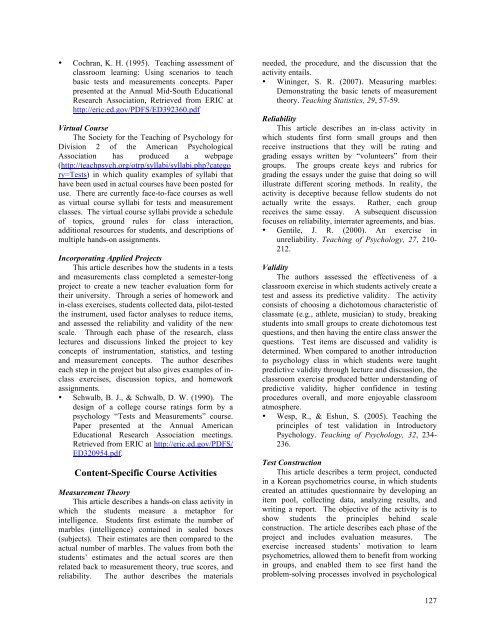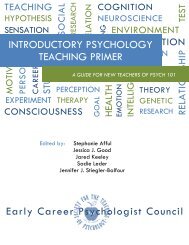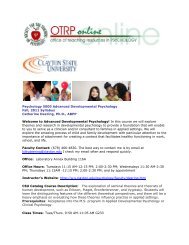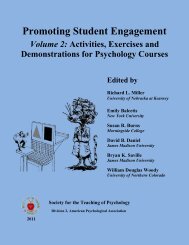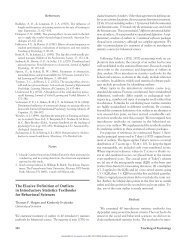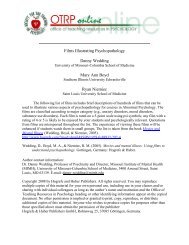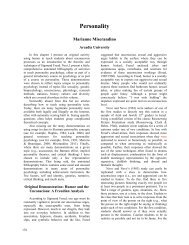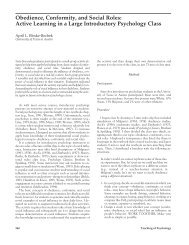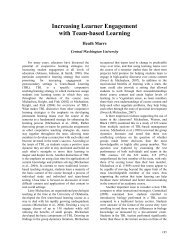Activities for Engagement in a Psychometric Course - Society for the ...
Activities for Engagement in a Psychometric Course - Society for the ...
Activities for Engagement in a Psychometric Course - Society for the ...
Create successful ePaper yourself
Turn your PDF publications into a flip-book with our unique Google optimized e-Paper software.
• Cochran, K. H. (1995). Teach<strong>in</strong>g assessment of<br />
classroom learn<strong>in</strong>g: Us<strong>in</strong>g scenarios to teach<br />
basic tests and measurements concepts. Paper<br />
presented at <strong>the</strong> Annual Mid-South Educational<br />
Research Association, Retrieved from ERIC at<br />
http://eric.ed.gov/PDFS/ED392360.pdf<br />
Virtual <strong>Course</strong><br />
The <strong>Society</strong> <strong>for</strong> <strong>the</strong> Teach<strong>in</strong>g of Psychology <strong>for</strong><br />
Division 2 of <strong>the</strong> American Psychological<br />
Association has produced a webpage<br />
(http://teachpsych.org/otrp/syllabi/syllabi.php?catego<br />
ry=Tests) <strong>in</strong> which quality examples of syllabi that<br />
have been used <strong>in</strong> actual courses have been posted <strong>for</strong><br />
use. There are currently face-to-face courses as well<br />
as virtual course syllabi <strong>for</strong> tests and measurement<br />
classes. The virtual course syllabi provide a schedule<br />
of topics, ground rules <strong>for</strong> class <strong>in</strong>teraction,<br />
additional resources <strong>for</strong> students, and descriptions of<br />
multiple hands-on assignments.<br />
Incorporat<strong>in</strong>g Applied Projects<br />
This article describes how <strong>the</strong> students <strong>in</strong> a tests<br />
and measurements class completed a semester-long<br />
project to create a new teacher evaluation <strong>for</strong>m <strong>for</strong><br />
<strong>the</strong>ir university. Through a series of homework and<br />
<strong>in</strong>-class exercises, students collected data, pilot-tested<br />
<strong>the</strong> <strong>in</strong>strument, used factor analyses to reduce items,<br />
and assessed <strong>the</strong> reliability and validity of <strong>the</strong> new<br />
scale. Through each phase of <strong>the</strong> research, class<br />
lectures and discussions l<strong>in</strong>ked <strong>the</strong> project to key<br />
concepts of <strong>in</strong>strumentation, statistics, and test<strong>in</strong>g<br />
and measurement concepts. The author describes<br />
each step <strong>in</strong> <strong>the</strong> project but also gives examples of <strong>in</strong>class<br />
exercises, discussion topics, and homework<br />
assignments.<br />
• Schwalb, B. J., & Schwalb, D. W. (1990). The<br />
design of a college course rat<strong>in</strong>gs <strong>for</strong>m by a<br />
psychology “Tests and Measurements” course.<br />
Paper presented at <strong>the</strong> Annual American<br />
Educational Research Association meet<strong>in</strong>gs.<br />
Retrieved from ERIC at http://eric.ed.gov/PDFS/<br />
ED320954.pdf.<br />
Content-Specific <strong>Course</strong> <strong>Activities</strong><br />
Measurement Theory<br />
This article describes a hands-on class activity <strong>in</strong><br />
which <strong>the</strong> students measure a metaphor <strong>for</strong><br />
<strong>in</strong>telligence. Students first estimate <strong>the</strong> number of<br />
marbles (<strong>in</strong>telligence) conta<strong>in</strong>ed <strong>in</strong> sealed boxes<br />
(subjects). Their estimates are <strong>the</strong>n compared to <strong>the</strong><br />
actual number of marbles. The values from both <strong>the</strong><br />
students’ estimates and <strong>the</strong> actual scores are <strong>the</strong>n<br />
related back to measurement <strong>the</strong>ory, true scores, and<br />
reliability. The author describes <strong>the</strong> materials<br />
needed, <strong>the</strong> procedure, and <strong>the</strong> discussion that <strong>the</strong><br />
activity entails.<br />
• W<strong>in</strong><strong>in</strong>ger, S. R. (2007). Measur<strong>in</strong>g marbles:<br />
Demonstrat<strong>in</strong>g <strong>the</strong> basic tenets of measurement<br />
<strong>the</strong>ory. Teach<strong>in</strong>g Statistics, 29, 57-59.<br />
Reliability<br />
This article describes an <strong>in</strong>-class activity <strong>in</strong><br />
which students first <strong>for</strong>m small groups and <strong>the</strong>n<br />
receive <strong>in</strong>structions that <strong>the</strong>y will be rat<strong>in</strong>g and<br />
grad<strong>in</strong>g essays written by “volunteers” from <strong>the</strong>ir<br />
groups. The groups create keys and rubrics <strong>for</strong><br />
grad<strong>in</strong>g <strong>the</strong> essays under <strong>the</strong> guise that do<strong>in</strong>g so will<br />
illustrate different scor<strong>in</strong>g methods. In reality, <strong>the</strong><br />
activity is deceptive because fellow students do not<br />
actually write <strong>the</strong> essays. Ra<strong>the</strong>r, each group<br />
receives <strong>the</strong> same essay. A subsequent discussion<br />
focuses on reliability, <strong>in</strong>terrater agreements, and bias.<br />
• Gentile, J. R. (2000). An exercise <strong>in</strong><br />
unreliability. Teach<strong>in</strong>g of Psychology, 27, 210-<br />
212.<br />
Validity<br />
The authors assessed <strong>the</strong> effectiveness of a<br />
classroom exercise <strong>in</strong> which students actively create a<br />
test and assess its predictive validity. The activity<br />
consists of choos<strong>in</strong>g a dichotomous characteristic of<br />
classmate (e.g., athlete, musician) to study, break<strong>in</strong>g<br />
students <strong>in</strong>to small groups to create dichotomous test<br />
questions, and <strong>the</strong>n hav<strong>in</strong>g <strong>the</strong> entire class answer <strong>the</strong><br />
questions. Test items are discussed and validity is<br />
determ<strong>in</strong>ed. When compared to ano<strong>the</strong>r <strong>in</strong>troduction<br />
to psychology class <strong>in</strong> which students were taught<br />
predictive validity through lecture and discussion, <strong>the</strong><br />
classroom exercise produced better understand<strong>in</strong>g of<br />
predictive validity, higher confidence <strong>in</strong> test<strong>in</strong>g<br />
procedures overall, and more enjoyable classroom<br />
atmosphere.<br />
• Wesp, R., & Eshun, S. (2005). Teach<strong>in</strong>g <strong>the</strong><br />
pr<strong>in</strong>ciples of test validation <strong>in</strong> Introductory<br />
Psychology. Teach<strong>in</strong>g of Psychology, 32, 234-<br />
236.<br />
Test Construction<br />
This article describes a term project, conducted<br />
<strong>in</strong> a Korean psychometrics course, <strong>in</strong> which students<br />
created an attitudes questionnaire by develop<strong>in</strong>g an<br />
item pool, collect<strong>in</strong>g data, analyz<strong>in</strong>g results, and<br />
writ<strong>in</strong>g a report. The objective of <strong>the</strong> activity is to<br />
show students <strong>the</strong> pr<strong>in</strong>ciples beh<strong>in</strong>d scale<br />
construction. The article describes each phase of <strong>the</strong><br />
project and <strong>in</strong>cludes evaluation measures. The<br />
exercise <strong>in</strong>creased students’ motivation to learn<br />
psychometrics, allowed <strong>the</strong>m to benefit from work<strong>in</strong>g<br />
<strong>in</strong> groups, and enabled <strong>the</strong>m to see first hand <strong>the</strong><br />
problem-solv<strong>in</strong>g processes <strong>in</strong>volved <strong>in</strong> psychological<br />
127


